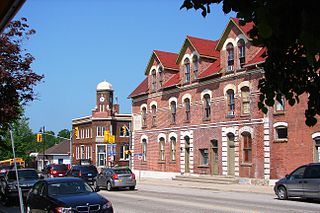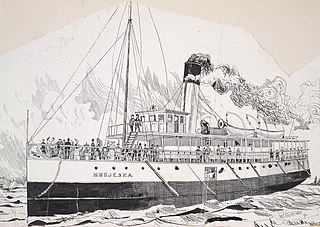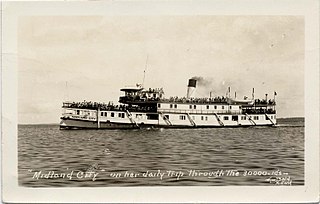
A steamship, often referred to as a steamer, is a type of steam-powered vessel, typically ocean-faring and seaworthy, that is propelled by one or more steam engines that typically move (turn) propellers or paddlewheels. The first steamships came into practical usage during the early 1800s; however, there were exceptions that came before. Steamships usually use the prefix designations of "PS" for paddle steamer or "SS" for screw steamer. As paddle steamers became less common, "SS" is assumed by many to stand for "steamship". Ships powered by internal combustion engines use a prefix such as "MV" for motor vessel, so it is not correct to use "SS" for most modern vessels.

A steamboat is a boat that is propelled primarily by steam power, typically driving propellers or paddlewheels. Steamboats sometimes use the prefix designation SS, S.S. or S/S or PS ; however, these designations are most often used for steamships.

Gravenhurst is a town in the Muskoka Region of Ontario, Canada. It is located approximately 15 kilometres (9.3 mi) south of Bracebridge, Ontario. Mayor Paul Kelly was acclaimed on July 27, 2018. The Town of Gravenhurst includes a large area of the District of Muskoka, known to Ontarians as "cottage country." The town centre borders on two lakes: Lake Muskoka, which is the largest lake in the region, and Gull Lake, a smaller cottage-bordered lake. Another lake, Kahshe Lake, is situated 10 kilometres (6.2 mi) south of the town.

The District Municipality of Muskoka, more generally referred to as the District of Muskoka or Muskoka, is a regional municipality in Central Ontario, Canada. Muskoka extends from Georgian Bay in the west, to the northern tip of Lake Couchiching in the south, to the western border of Algonquin Provincial Park in the east. A two-hour drive north of Toronto, Muskoka spans 6,475 km2 (2,500 sq mi). Muskoka has some 1,600 lakes, making it a popular cottaging destination.

Royal Mail Ship, usually seen in its abbreviated form RMS, is the ship prefix used for seagoing vessels that carry mail under contract to the British Royal Mail. The designation dates back to 1840. Any vessel designated as "RMS" has the right both to fly the pennant of the Royal Mail when sailing and to include the Royal Mail "crown" insignia with any identifying device and/or design for the ship.
Nipissing may refer to the following places in Ontario, Canada:

Lake Muskoka is located between Port Carling and Gravenhurst, Ontario, Canada. The lake is surrounded by many cottages. The lake is primarily within the boundary of the Township of Muskoka Lakes, the southeast corner is within the boundary of the Town of Gravenhurst and another small portion around the mouth of the Muskoka River is within the boundary of the Town of Bracebridge. The town of Bala is located on the southwest shores of the lake, where the Moon River starts. Lake Muskoka is connected to Lake Rosseau through the Indian River and lock system at Port Carling. The lake is mainly fed by the Muskoka River, Lake Joseph and Lake Rosseau.

The Huntsville and Lake of Bays Transportation Company was a company chartered in 1895 to operate steamboats on the Lake of Bays, and a series of lakes connecting to Huntsville in the northern section of the Muskoka Lakes District of Ontario, Canada. The wholly owned Huntsville and Lake of Bays Railway ran a short line narrow gauge railway to connect steamboats operating on Lake of Bays and Peninsula Lake outside Huntsville, Ontario. Covering a vertical distance of 175 feet (53 m) along the hilly 1.125-mile (1.811 km) route, it was known as the "smallest commercially operated railway in the world".

The history of commercial passenger shipping on the Great Lakes is long but uneven. It reached its zenith between the mid-19th century and the 1950s. As early as 1844, palace steamers carried passengers and cargo around the Great Lakes. By 1900, fleets of relatively luxurious passenger steamers plied the waters of the lower lakes, especially the major industrial centres of Chicago, Milwaukee, Detroit, Cleveland, Buffalo, and Toronto.

The Baltimore Steam Packet Company, nicknamed the Old Bay Line, was an American steamship line from 1840 to 1962 that provided overnight steamboat service on Chesapeake Bay, primarily between Baltimore, Maryland, and Norfolk, Virginia. Called a "packet" for the mail packets carried on government mail contracts, the term in the 19th century came to mean a steamer line operating on a regular, fixed daily schedule between two or more cities. When it closed in 1962 after 122 years of existence, it was the last surviving overnight steamship passenger service in the United States.

Wenonah II is a modern excursion vessel constructed to offer passengers the look and feel of the early 20th century steamships. She is homeported in Gravenhurst, Ontario, and is operated by Muskoka Steamships, which also operates RMS Segwun. Segwun is the last surviving original steamship from the fleet of several dozen that served the county of Muskoka, Ontario in the late 19th and early 20th centuries.

Wenonah was a sidewheel steamship, built by Alexander Peter Cockburn, on Lake Muskoka, in 1866. She was the first vessel employed by the Muskoka Navigation Company. She carried passengers, mail and freight, and towed logs for the lumber industry, mainly on a cluster of connected lakes that covered much of the county of Muskoka, Ontario, Canada. Some sources also say she was the first steamship on the Magnetawan River, north of Muskoka.

SS Manitoulin was a Great Lakes passenger steamship. She was built in 1889 as Modjeska, and renamed Manitoulin in 1927 after a major refit. She was laid up in 1949 and scrapped in 1953.

SS Columbia (1880–1907) was a cargo and passenger steamship that was owned by the Oregon Railway and Navigation Company and later the San Francisco and Portland Steamship Company. Columbia was constructed in 1880 by the John Roach & Sons shipyard in Chester, Pennsylvania for the Oregon Railway and Navigation Company.
The Muskoka Wharf is located in the town of Gravenhurst, Ontario on the southern edge of Muskoka Bay on Lake Muskoka. The Muskoka Wharf is the home port of the RMS Segwun, the oldest operating steamship in North America and the last surviving original steamship from the fleet of several dozen that served the county of Muskoka, Ontario in the late 19th century and early 20th century, and the Wenonah II, a modern replica of an early 20th-century steamship. The Muskoka Wharf, once a vibrant hub of economic activity at the union of a major railroad terminus and steamship port, fell into decline as roads and automobiles were introduced to the region, but has experienced a major economic resurgence since the creation of a heritage-based development area in 2005.

SS Midland City was originally a Canadian side-wheel steamboat that provided passenger and cargo transportation on the Great Lakes from 1871 until 1955. Originally named Maud, then America, she underwent several extensive refits over her 84-year service, and saw several owners. The ship was intentionally run aground and burnt to the waterline in 1955 near the mouth of the Wye River in Midland Bay. The wreck is intact and visible above the water to this day, where it acts as a breakwater for the Wye Heritage Marina and local attraction.
SS Bigwin is a small steamship ferry that plies the waters of Lake of Bays in Muskoka area of Ontario.

John B. Fraser was a steamship lost on Lake Nipissing with considerable loss of life. Seven men survived. Thirteen corpses were found. Four men were never accounted for.

















